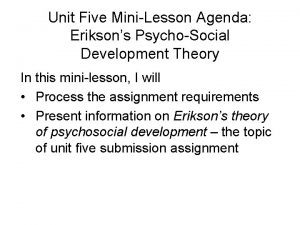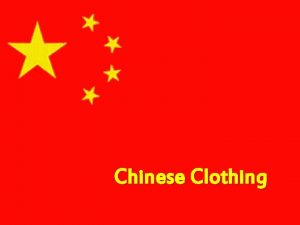Stagnation in the Childrens Department US childrens clothing










- Slides: 10


Stagnation in the Children’s Department • US children’s clothing market revenues increased 4% during 2016, to $31. 6 billion. Girls’ apparel (ages 4– 14) had the largest share of the market, at 38%. Boys’ apparel (ages 4– 14) was second at 33%, then baby-and-toddler wear (ages 0– 3) at 29%. • Girls’ and boys’ apparel categories increased 4%, while baby-and-toddler wear only increased 2%. By 2020, the population aged 0– 3 is forecasted to represent 5% of the total US population, while the age group 4– 14 is expected to decline to 13%. • According to the US Census Bureau, family clothing store sales (unadjusted) remained flat during the first half of 2017, at $44. 993 billion, increasing a meager 0. 005%, compared to the first half of 2016, or $44. 989 billion.

Struggling and Suffering Stores • Some children’s and teen specialty retailers declared bankruptcy and/or closed stores during 2017, including Gymboree (350), The Children’s Place (200), rue 21 (400), Abercrombie & Fitch (60) and Wet Seal (171). Carter’s plans to add 250 stores this year. • During 2016, households with children shopped at an average of 11. 2 retailers during the previous 4 weeks, compared to 8. 8 for households without children, and 9. 4 overall. • More children’s clothing than any other category of clothing or footwear is bought online. Experts cite parents’ lack of time to shop in-store as a major factor. On the positive side for stores, though, is inconsistent sizing of kids’ clothes online.

When School Bells Ring • Children’s apparel is more seasonal than any other type of apparel. During November 2016, the index for children’s clothing was 105, compared to women’s casual clothing (86), women’s dress clothing (78) and men’s clothing (85). • Back-to-school shopping accounts for approximately 17% of total annual sales, with children’s apparel and accessories 34. 7% of the total spent on back-to-school. The average amount spent on clothing per child during the 2017 season was $238. 89. • For the 2017 back-to-school season, fewer consumers said they planned to shop at department stores (28%, compared to 54% during 2016) and specialty clothing stores (8%, compared to 25% during 2016). Share shifted to off-price and mass merchants.

Saving Time, Spending More Online • Parents spend more time shopping online than non -parents: 7 hours per week for parents versus 4 hours for non-parents. They also spend 61% more money online ($1, 071) compared to non-parents ($664). • A larger percentage of non-parents shop online than parents, or 47% and 41%, respectively, while a larger percentage of parents shop in-store than non-parents, or 59% and 53%, respectively. • In a survey by KPMG, 23% of consumers said they planned to purchase children’s apparel online during the next year, an increase of only 0. 8%. Stores can compete with omnichannel strategies by making shopping convenient for parents and fun for kids.

Must-Have Designer Looks • Designer clothing is an increasing segment of the children’s apparel market. During 2016, the average pair of luxury children’s shoes cost $166, compared to $48 for the whole market, while a luxury children’s T-shirt cost $74, compared to $19 overall. • Older parents who have more money to spend on their children and the ubiquity of photos of celebrity children on social media and in magazines, such as North West and Blue Ivy, and Shiloh Jolie-Pitt dressed in designer clothing, are the drivers of this trend. • The mini-me trend, with adults and children wearing matching or similar clothing, is also increasing. The three biggest trends are bomber jackets (263% increase from 2015), cold shoulder tops and dresses (+120%) and activewear (+27%), as of July 2016.

Market Trends That Sell • Another trend in children’s clothing is genderneutral clothing. During 2016, there were 212, 000 children’s clothing products. Of those, 109, 000, or 51. 4%, were for girls; 82, 000, or 38. 7%, were for boys; and the remaining 21, 000, or 9. 9%, were unisex. • Many clothing brands are expanding their selections to include plus sizes for children, including The Children’s Place, Justice and Old Navy. • Just like in the adult clothing market, comfort is a primary preference, with athleisure items selling well. Denim is trending, including ripped, oversize jackets and jeggings. Graphic print T-shirts and sweatshirts with slogans are also popular.

Advertising Strategies • Retailers can focus on the kid version of fast fashion to save harried and budget-conscious parents time and money. • Implement and advertise click-and-collect services that allow parents to order online and pick up in store. • Showcase mini-versions of adult styles with images of similar styles on adult runway models.

New Media Strategies • Announce a giveaway on Instagram of a popular item. Instagram followers must comment on why they want to win the item in the photo and tag three friends who they think would want it as well. • Send customers a birthday card in the mail with the offer of a free gift in-store. • Send new products to mommy bloggers to review.




















